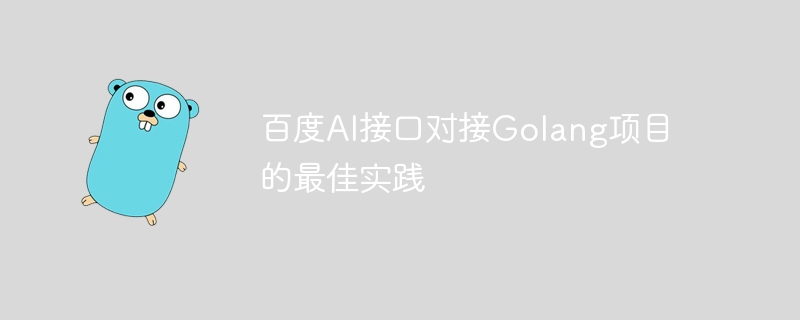Home >Backend Development >Golang >Best practices for Baidu AI interface docking with Golang projects
Best practices for Baidu AI interface docking with Golang projects
- WBOYWBOYWBOYWBOYWBOYWBOYWBOYWBOYWBOYWBOYWBOYWBOYWBOriginal
- 2023-08-27 12:39:171194browse

Best practices for Baidu AI interface docking with Golang projects
Introduction:
In today’s wave of artificial intelligence, Baidu AI interface has become many One of the first choices for developers and enterprises to implement intelligent applications. As a fast and efficient programming language, Golang is recognized by more and more developers and used in various projects. This article aims to discuss how to best connect Baidu AI interface in the process of using Golang to develop projects, and explain the specific implementation method in detail through code examples.
1. Preparation work
Before starting to connect to Baidu AI interface, we first need to complete some preparation work.
- Register a Baidu AI Open Platform account: Register a developer account on the official website of Baidu AI Open Platform (https://ai.baidu.com/) and obtain the API Key and Secret Key.
- Install the Golang environment: Make sure that the Golang running environment has been installed on the local computer and set the corresponding environment variables.
- Install related dependency packages: We will use the third-party HTTP library "net/http" and JSON processing library "encoding/json" of the Go language to perform API requests and data parsing. Install these two packages through the following commands:
go get github.com/go-chi/chi go get -u github.com/gorilla/websocket
2. Use Baidu AI interface
After preparing the development environment, we start to use Baidu AI interface. Taking Baidu text recognition interface as an example, we will explain how to make interface calls in Golang projects.
- Import the required packages:
import (
"encoding/base64"
"encoding/json"
"fmt"
"io/ioutil"
"net/http"
"net/url"
"strings"
)- Define the Baidu text recognition interface request parameter structure:
type OCRRequest struct {
Image string `json:"image"`
LanguageType string `json:"language_type"`
}- Define Baidu text recognition interface return data structure:
type OCRResponse struct {
WordsResult []WordsResult `json:"words_result"`
}
type WordsResult struct {
Words string `json:"words"`
}- Define Baidu text recognition interface request function:
func OCR(imageBase64 string) (string, error) {
apiURL := "https://aip.baidubce.com/rest/2.0/ocr/v1/general_basic"
image := url.QueryEscape(imageBase64)
params := url.Values{}
params.Add("image", image)
params.Add("language_type", "CHN_ENG")
req, _ := http.NewRequest("POST", apiURL, strings.NewReader(params.Encode()))
req.Header.Set("Content-Type", "application/x-www-form-urlencoded")
req.Header.Set("Content-Length", strconv.Itoa(len(params.Encode())))
reqParams := req.URL.Query()
reqParams.Add("access_token", "YOUR_ACCESS_TOKEN")
req.URL.RawQuery = reqParams.Encode()
client := &http.Client{}
resp, err := client.Do(req)
if err != nil {
return "", err
}
defer resp.Body.Close()
respBody, _ := ioutil.ReadAll(resp.Body)
var ocrResponse OCRResponse
err = json.Unmarshal(respBody, &ocrResponse)
if err != nil {
return "", err
}
result := ""
for _, words := range ocrResponse.WordsResult {
result += words.Words + "
"
}
return result, nil
}- Call Baidu text recognition interface and Output result:
func main() {
imageFile, _ := os.Open("test.jpg")
defer imageFile.Close()
imageData, _ := ioutil.ReadAll(imageFile)
imageBase64 := base64.StdEncoding.EncodeToString(imageData)
result, err := OCR(imageBase64)
if err != nil {
fmt.Println("OCR failed:", err)
return
}
fmt.Println("OCR result:", result)
}Summary:
Through the above code example, we can see how to use Baidu AI interface to implement text recognition in the Golang project. Connecting with Baidu AI interface allows our projects to quickly gain powerful artificial intelligence capabilities and provide users with smarter services and experiences. Of course, we can also call other Baidu AI interfaces to implement functions such as speech recognition and image recognition according to specific business needs. I hope this article will be helpful to everyone when connecting to Baidu AI interface.
The above is the detailed content of Best practices for Baidu AI interface docking with Golang projects. For more information, please follow other related articles on the PHP Chinese website!

